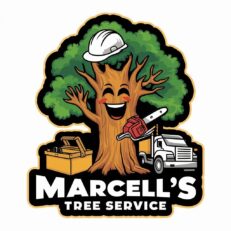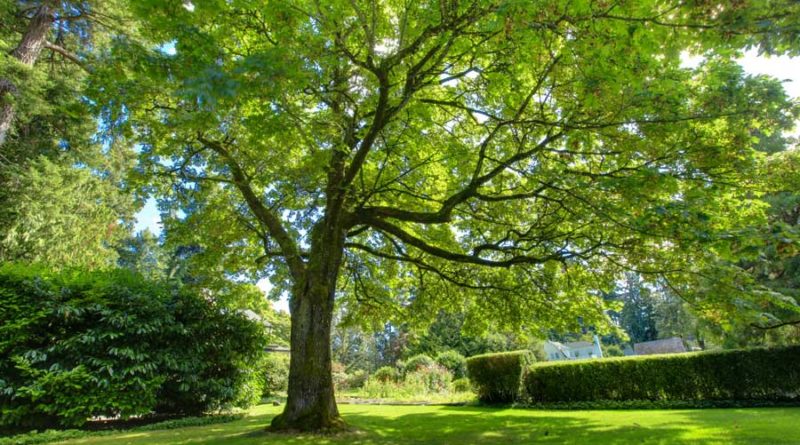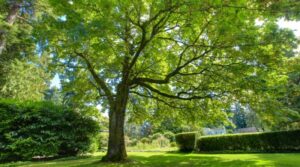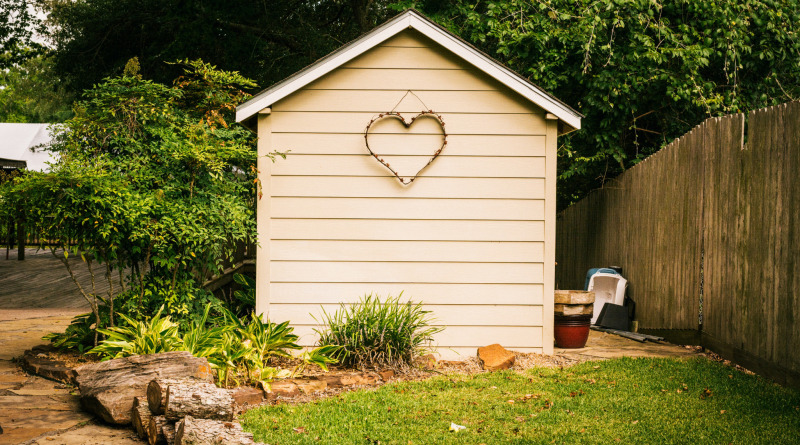Do Maple Trees Have Acorns? No. Acorns Are Oak Tree Seeds. Instead, they produce a fruit called a samara which holds the seeds of the tree.
Do Maple Trees Have Acorns?
What are samaras?
Helicopters, keys, and whirlybirds. All of these are names used to characterize the maple’s unique seed the samara.
A samara is composed of a pair of connected, winged seeds. Certain maples will bring forth double samaras. And amazingly, some even manage to produce triple samaras.
Once the samaras transform from their natural green color to red, yellow, or brown.
They drop to the ground in a twirling corkscrew pattern. These whirlybird-shaped pods entrance and gladden the hearts of both children and adults.
While the features of maple trees are notably diversified, all of them produce samaras. The length of time maples spends shedding their seeds.
And the time of year in which they do it differs from species to species, sometimes radically, but maples send forth their seed-bearing samaras over several weeks.
Depending on the species, maple trees generally flower from spring to early summer.
The female flowers create the samara. Each samara holds a single seed attached to an irregular wing-like projection.
That, through a complex aerodynamic process, makes the seed spin rapidly while falling, resembling a helicopter propeller.
Even damaged samaras will normally rotate well. Interestingly enough, the spiraling movement of the samara helps the seed to remain aloft.
For a period of time that is longer than if the seed were merely subject to the pull of gravity.
Causing samaras to seem as though they were flying. Or floating as the wind carries them away from their parent tree.
If the proper conditions exist. This spinning motion can carry the samara great distances from its parent.
How Maple seeds Disperse.
Every year during the spring and summer. Blasts of wind send whirling clusters of maple seeds flying through the air to land on the earth.
They, in turn, clutter patios and roadways. And out of all this chaos, only a few lucky seeds manage to germinate.
Take root and mature into full-grown maples. An intricately engineered wonder of nature.
The maple seed is a fine example of how evolution has favored designs. That permits trees to widely spread their seeds about.
Rather than just letting them fall on the ground.
Do Maple Trees Have Acorns? No. Acorns Are Oak Tree Seeds
Over the millennia. Plants have developed many different methods of dispersing their seeds away from themselves.
Commonly enlisting the help of the wind. As maples do carry seeds far from the parent plant.
Spreading seeds about so widely. Keeps the parent from being forced to share limited resources such as water, nutrients, and light.
With their offspring like they would if they were growing up nearby. Especially in the case of trees.
Seeds have to disperse away from the parent tree’s canopy. Where they have a chance of obtaining enough light for healthy growth after germination.
After dispersal.
Samaras typically grow in pairs, but usually, only one seed will germinate. So sibling trees aren’t required to do battle for the same resources.
Maples produce samaras at different times of the year, depending on the species. With some beginning germination immediately upon hitting the ground.
Others wintering and germinating the next spring. The germination of maple samaras has a high success rate.
Thus allowing stands of maples to quickly reproduce themselves. Seeds also provide food for wildlife and birds and, deer have a fondness for maple seedlings.
Do Maple Trees Have Acorns? No. Acorns Are Oak Tree Seeds
Certain types of maple form unique fruit that distinguishes them from each other. But the similarities make them easy to identify.
The two-sided maple samaras hold two facing nutlets connected to flat, papery wings. Each nutlet holds one maple seed.
Seeds turn up on trees around a month after spring flowering. And mature at different rates. Not all species of maple have the same color and size as samaras.
And the number of days trees normally shed their unique seeds differ as well.
Sugar Maple.
The sugar maple (Acer saccharum), grows abundantly in eastern Canada and the northern states. A slow-growing tree, it eventually achieves heights of 100 feet or more.
Long-stalked, yellowish-green sugar maple flowers. Arrive on the scene in early spring along with the leaves.
The samaras in turn, with their 1-inch wings. Ripen from the beginning of summer into autumn.
It’s about two weeks after samaras mature, that sugar maples begin their long-lasting release. Sugar maples do not begin seeding until they are around 30 years old.
Achieving maximum seed production when they are 60 years old. Incidentally, seed production reaches its height every two to five years.
Silver Maple.
The silver maple (Acer saccharinum), unites a short trunk. With long-reaching limbs to reach a height of 100 feet tall.
In most land and ideal conditions, it undergoes rapid growth. Silver maple flowers appear early on in spring, well in advance of its leaves.
They grow in thick, green-yellow or red-yellow clusters. Abundant samara fruit grows on slender, flexible stems and begins to ripen in spring.
Silver maples release their consistently plentiful crops immediately after the fruit ripens. The shedding is brief, less than two weeks.
Eleven years of age is generally the time when seed production begins.
Red Maple.
The red maple (Acer rubrum), is widely distributed throughout the United States. A medium-sized tree, it grows moderately amid moist, acidic soil.
Flower buds arrive in dense clusters in late winter and early spring. Turning deep red before they open. Its small samara fruit grows on long, sagging stems with wings less than 1 inch long.
They start out red or green in color. And are dispersed as spring ends. Red maple trees start growing seeds at four years of age. But it takes alternating years to produce heavy seed crops.
Planting Maple seeds.
Once they have fallen to the ground the samaras can be collected and planted. But this isn’t a case of one step fits all.
The steps required for planting maple seeds depend on the type of maple tree you intend to plant. For instance, some maple seeds need stratification.
Which is a type of pretreatment. That simulates the natural conditions that a seed goes through before germination.
Difference between an Oak tree and a Maple tree.
While it is true that maple trees and oak trees do look quite a bit like in stature and foliage, there are some very real differences between them.
Oaks and maples do have in common that they are deciduous trees, both losing their leaves in the fall, with new growth than developing in the spring.
However, the overall appearance of these two trees is vastly different. Oaks have rougher and more gnarled bark than maples do.
If you run your hand across each of them in turn, you will feel that the bark of oak is thick and quite rough, with long, deep fissures that run vertically along the trunk, whereas maple is much smoother and even appears finer to the eye.
The color of oak bark is generally a grey-brown shade (White Oak), with Red Oaks having a brown-brick or reddish type of coloring.
Do Maple Trees Have Acorns?
Yet another way of identifying an oak tree is by its foliage. Oak leaves are long and keep a constant width along their entire length. Plus, the leaves of oak are usually dark green with a thick, strong stem.
When an oak leaf is held up to the light, it’s easy to see the wood-like veins that run along with the whole leaf. They actually feel leathery and are hard to tear.
Now maple leaves, on the other hand, have a broad base and fragile, horizontal offshoots. Their leaves and stems are a great deal softer to the touch than that of the oak, and they are easy to tear.
The branches of an oak tree can be so twisted and gnarled that they appear as if they have actually been abused. Maples don’t have this problem, as they have consistent and organized growth.
When you see an old oak, you will notice that the trunk is normally rather thick.
With a diameter that the arms of your average adult cannot go completely around. Oaks have the ability to sometimes appear as if there are several trees growing from the same roots.
Because of their great strength and sturdiness, many oaks actually have big caverns dug directly into them and still continue to survive, even though their state would almost surely kill other species of trees.
An oak can grow to be extremely, amazingly tall, frequently reaching 70-100 feet in height, which makes it one of the tallest trees in any forest.
Wine and whiskey makers find oak wood comes especially handy for them. Wine is aged in barrels that are made of fine oak, and sauvignon blanc and chardonnays are known to absorb the fragrance of the wood barrel.
While maple wood is definitely harder than oak.
You must keep in mind that hardness is not always the same as durability. In a touch of irony, harder woods can be vulnerable to decay, and softer wood can withstand it.
It all comes down to where you intend to use the hardwood rather than thickness and hardness. And you should remember further, that various sub-species of each tree also play their essential parts when making the choice of oak or maple.
Oakwood comes in two varieties, white and red. It’s possible to break both down into around 10 or more subspecies.
Do Maple Trees Have Acorns? No. Acorns Are Oak Tree Seeds
When comes to maple, this wood also has two types, soft and hard. The category of soft maple is divided into yet another seven types.
This is why it is easier for most builders and those who work with wood to speak of oak and maple generically because basically there are two kinds, red oak and hard maple which are the most commonly used.
Should you be uncertain about what kind you’re working with, check the price of the wood to help you. Soft maple costs less than hard maple. White oak should cost more than red oak, but it is harder to obtain.
Finally, the easiest way to tell the difference between an oak and maple is by taking a good look at the seeds. Oaks create acorns, which serve as their seeds for reproducing.
Maples make seed pods, frequently called helicopters because of their spiraling action when they fall to the ground in the fall.
About Maples
Here are some interesting facts about maple trees:
1. There are many varieties of maples, 13 of which happen to be native to North America, including sugar maple, black maple, and red maple. Maples vary in size from the small, 8 ft Japanese maple to the large, 100-foot sugar maple.
2. The maple tree belongs to the family Sapindaceae of which there are 128 species. While most are native to Asia, there are many that have also turned up in Europe, northern Africa, and North America. However, there are only one species that traveled as far as the Southern Hemisphere.
3. Most species of maple are deciduous, as well as being known for their spectacular displays of autumn leaves, but several located in the Mediterranean area and in southern Asia are actually evergreen.
4. The best conditions for maple trees to germinate are in cold weather where the temperature is at least 34 degrees F.
5. These trees are inclined to grow best in clay-like or sandy soil. All that’s required is for the soil to stay loose and the soil depth to be enough to permit the roots to anchor the tree to the ground, and the maple tree will do the rest.
Do Maple Trees Have Acorns?
6. Depending on what species it is, maples can live for between 100 and 400 years.
7. The oldest maple tree alive in Canada is the Comfort Maple, a gigantic and oddly shaped sugar maple tree which is reported to be 500 years old or more.
8. Frequently maples have root systems that are so fibrous and dense, that they prevent the growth of any other vegetation beneath them.
9. The average maple will continue growing to a height of 33-148 ft. Still, others are no more than shrubs, reaching only 10 meters tall with many small trunks making their appearance at ground level.
10. A maple tree will typically have gray or brown bark that is smooth in younger trees and becomes rougher in trees that are older.
Fun facts about Maple trees
- Because most maples are blessed with brilliant autumn foliage, there are many countries that have leaf-watching customs. For instance, in Japan, the tradition of viewing the changing color of the maple trees in autumn is referred to as “Momiji gari”. The sugar maples are a great draw for fall tourists here in North America.
- Japanese maple, Amur maple, Field maple, Montpellier maple, and Trident maple are all top choices for the art of bonsai creation. That’s because they have a great reaction to methods employed to cause leaf reduction, but you can use almost any species of maple.
- When looking for sap, it is the Sugar, Red, and Black maple trees that are tapped. The sap is then boiled to make maple syrup or turned into maple sugar or maple taffy. It requires around 42 Qts of sugar maple sap to make 1.1 Qts of maple syrup. Any species of maple can be tapped to obtain syrup, many do not carry enough sugar to be sold.
- Canada has a maple leaf on its coat of arms, as well as on the Canadian flag. Because the maple is a universally understood symbol of forbearance and strength.
- It has been chosen as Canada’s national tree. Maple leaves are traditionally considered an important part of Canadian Forces military regalia, being used as the military rank insignia for generals.
- Maple is thought of as a tonewood. What’s a tonewood? That’s a wood that transmits sound waves well and is used in many musical instruments.
Do Maple Trees Have Acorns? No. Acorns Are Oak Tree Seeds
- In fact, although most people don’t know this, the back, neck, and sides of most violins, violas, double basses, and cellos are made from good old-fashioned maple.
- Electric guitar necks are frequently composed of maple because it provides excellent dimensional stability. And many drums too are made from maple.
- Maple wood actually seems to be extremely versatile and is used to make furniture, bowling pins, baseball bats, bowling alley lanes, butcher’s blocks, and even pool cue shafts.
It’s really pretty amazing when you think about the things that are made of maple.
- Furthermore, the paper industry uses maple wood too. Paper made of maple trees is said to have wonderful printing properties.
- And dried maple wood is utilized when smoking food.
- Maple syrup was first made back in 1540 by Native Americans who used the sap of the sugar maple to make it. In fact, the North American natives the Iroquois had a feast that was held in honor of maple.
- The oldest fossil of a maple tree ever found dates back to 100 million years ago in Alaska.
- In Japan, they have a type of snack, which is made from maple leaves that have been soaked in salt for a year, which are then placed in a sweet dough and fried.
- Nearly all of the types of maple that we know are used for decorative purposes.
Maple trees are not found in the world’s largest forest, the Siberian taiga.
- Although this is not a well-known fact, the image of the maple leaf found on the Canadian flag is not authentic, because the leaf has only 11 vertices. In reality, maple leaves have many more of them.
- An older maple tree can achieve a remarkable height of 40 meters.
- Maple wood is the most in-demand with woodcarvers. It features a honey-like color.
- There is a type of sweet syrup and sugar that can be made from the juice of the maple tree types.
- It is a habit of beekeepers to plant maples close by, as these trees make wonderful honey plants, and bees really enjoy them.
- Back in 2005, coins made out of maple wood were used in the Democratic Republic of the Congo.
- A maple shrub can reach a height of 32-33 feet.
- The Japanese maple is listed in the IUCN Red List book because it is considered rare.
- Bark of maple trees has some powerful and useful properties which are used to help ease the pain of sore eyes.
- The inner bark is part of a tea that is used to cure both stomach infections and cough. Furthermore, maple syrup is considered a healthy food and can be used in place of sugar.
- Maple syrup is actually used as a dressing in certain desserts.
- They supply dense and clean firewood which is great for burning.
Getting that maple syrup
- As mentioned above, sugar, red, and black maples are the maple trees primarily used in the making of maple syrup. But there’s lots more about the process that you don’t know.
- Don’t fret, most people don’t know all of this stuff because they simply aren’t part of the maple syrup-making industry.
- If you are raising sugar maples, in a well-balanced, thriving sugarbush the number of maples you would hope to have would be around 70 per acre.
- Do Maple Trees Have Acorns? No. Acorns Are Oak Tree Seeds
- While maple trees can live for 200 years and even much longer, the longest and has been tapped is for around 150 years.
- When a maple tree is considered ready for tapping, it needs to be at least 10″ in diameter. In a forest, when you come across a tree that large, it could be anywhere from 50-60 years old.
- Out of all the maple species that are out there, the sugar maple is the one that contains the highest quantity of sugar in its sap.
- It usually averages in the 2.0-2.5 range but can vary from one tree to another and changes from day to day even if you stay within the same sugarbush.
- The maple is one of the fastest-growing trees that we know of. It can actually grow 4-6 ft in a year.
- Don’t look for maple trees in the Southern hemisphere. Nearly all species of maple grow in the Northern hemisphere.
- There are just one known species out of 150 that actually grows in the Southern hemisphere.



